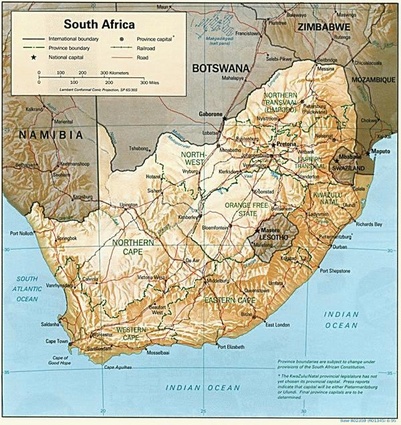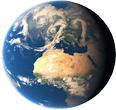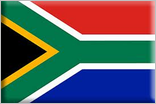





| Augrabies Falls are the second biggest of Africa. The water is plunging down a narrow gorge, which can be viewed from different platforms along the rim of gorge. The falls are nice, but the surroundings are just as interesting. There are several trails that lead through the rocky habitat that are home to many different animals including the very conspicious rock hyraxes and baboons. With a bit of luck you can see Klipspringer. |

| Mkuze is not a national park, 'just' a game reserve. But don't be fooled; it's a little gem! We really loved this park. In terms of mammals it's a great place to see species like white rhino, nyala, suni and natal duiker, which all have a restricted distribution range. We were lucky to additionally see cheetahs and a leopard. Furthermore, Mkuze is well known for its birds: around 400 species have been documented here. Especially the fig-forest, which you can visit with a guide is a great place to search for some specialties such as Turacos, hornbills and barbets. For us however, the highlightwere the waterholes at which we found up to 7 species of mammals gathered there at the same time (eg wildebeest, white rhino, Nyala, warthog, baboon, zebra). |
| This park is one of the best in South Africa. The park consists of dry rolling sand hills of the Kaglagadi semidesert, intersected by (dry) riverbeds. Despite the apparent harsh environment, it is home to many enigmatic large mammal species, such as giraffes, hartebeests, wildebeests, oryxes and springboks. However the park is rightiously famous for its predators. You have good chances of spotting cheetah, leopard, black-maned lion and even african wildcat, caracal or Brown Hyena. Also the feathered predators are well represented with many falcons, hawks, eagles and vultures. The roads in the park follow the dry riverbeds, in which may natural or artificial waterholes are located. Since water is a scarce commodity it attracts a lot of wildlife. We really loved this park and can especially recommend the camps at Nossob and mata-mata which are more remote and are better for wildlife watching than Twee rivieren which is the main entry point. |

| The garden route is kind of misnomer if you ask us. Don't get us wrong; it's a very beautiful stretch of coast a big diversity of towns and nature. However, we haven't seen any gardens... We visited wilderness park and Tsitsikamma NP. Both are very beautiful, great for hiking and birdwatching. Especially Storms river mouth on the east side of Tsitsikamma is very scenic with a very wild coast. |

| A visit to Blyde (Dutch for happy) river canyon is a nice sidetrip from Kruger National Park, if you want to have a brak from the big game. The canyon is one of the biggest in the World (30km long) and very beautiful. Along the rim of the canyon, there are several lookout points that are accessible by car. In addition to the Canyon itself there are also a couple of other interesting places to visit, including the Bourcks Luck potholes with its strange holes in the rocks due to erosion by theTreur (Dutch for 'mourning') River. |

| This park is one of our favourite parks in South Africa. It harbours a typical mountainous Karoo biotope: very arid, but with a surprising abundance of wildlife. Since there are few trees, animals are easy to spot and therfore gamedrives are very rewarding. Typical species include Red Hartebeest, Greater Kudu, Cape Mountain Zebra, Steenbok and Oryx. In addition is one of the best places in South Africa to see the funny looking Klipspringer. Many Karoo specific birdspecies can be found in the park as well. |

| Cape Town is one of the most dramatically located cities in the world. 1000m high Table mountain towers over the city. Obviously one the main attractions is the cablecar up the mountain. This is probably only rivalled by Robben Island, where Nelson Mandela spent 30 years in prison. Furthermore, the waterfront despite being very commercial worth a visit, with many shops restaurants and several museums. Given the importance of Cape Town in European trading with and colonialization of Africa and Asia, visiting one of the musea focusing on the history of the city is well recommended. When visiting Cape Town a daytrip to the Cape Peninsula is a must. Fantastic vistas along the coast, closeup encounters with penguins, tasty seafood and great hiking in the mountains. Finally, the city is also one of big contrasts: On the one hand there is the rich and wealthy center of town, while on at the same time people live in apalling conditions in shantitowns a couple of kilometres down the road. It clearly shows that despite the abolishment of the apartheid, there is still a big gap between the mostly white upperclass and the predominantly black lowerclasses. We stayed in Blencathra, a great affordable guesthouse in the Gardens with spectacular views on both the Table Mountain and the city center. |

 |
 |
 |
 |
 |

| Probably it is the best park in Kwazulu Natal. If you're interested in rhino's this is the park to go. Both White and Black Rhino liove here in healthy numbers and sighting are very common. In addition, lions, Leopard, buffalo and Elephants also roam this park. So the big five is present. More interesting though are the presence of cheetahs, Wild Dogs and Nyala, which are difficult to spot in other parks in South Africa. The scenery is very diverse, with rivers, mountains, plains and forests. Not surprising, also birdlife is prolific, especially the raptor are well represented. |

| This park is the flagship of the Nature conservation in Africa. Everybody knows Kruger National Park. It is a huge park that can hardly be done justice in a couple of days. Most people visit the southern part of the Park, which has the highest density of big game. It's immensely popular and all the camps are often fully booked weeks in advance. We hadn;r booked any campsites and we had a hard time finding accomodation in May, not particularly the high season. If you're visiting this park to get back to nature, you may return disappointed, as most camps (skukuza and Lower Sabie) are little villages, which stores, restaurants etc. The camps further north, though, have a more wild feel. The major road are paved throughout the park, which is convenient for drivers, but it feels like you're driving in a big zoo. In terms of wildlife, we were not that impressed. Probably we were unlucky as is had rained a lot just before we arrived. As a result everything was very green and the animals were more difficult to spot. On the other hand, the birding was amazing, with about 200 species spotted from the car in a couple of days. |

| These wetlands and the adjacent park harbour a wealth of aquatic and terrestrial life. On a boattrip you'll have guaranteed sightings of hippos, vervet monkeys and Fish Eagles. Visiting the park encompassing the narrow strip of land in between the lagoon and the sea and staying overnight at Cape Vidal is definately recommended, as you're to spot White Rhino, Natal Duiker, Samango Monkey and Greater Kudu. Birders should look out for Livingstones Touraco, SquareTailed Drongo and many other bird species reaching the southern limit of their distribution in this park. |
| Physical activities: eg Walking / Rafting / swimming Nature: eg National Park / Reserve City / Cultural site |
 |
 |
 |
 |
 |
 |
 |
 |
 |
 |
© Bart Everts
 |

 |
 |
 |
 |
 |
 |
 |

| The Drakensbergen are prime hiking country, where you could spend weeks exploring the different mountain ranges. Several parks have been erected along the eastern slopes of the Drakensbergen that lie within South Africa. The most Northern Park, Golden Gate, is less well known for hiking as it is for game viewing. This park is probably your best bet for spotting blesbok and Blacktailed Wildebeest. Further South lies Royal Natal National Park, which harbours one of the most spectacular views on the mountains. It's called the amphitheatre: a ridge of mountains at about 3300m altitude. A great way to appriciate this park is to walk the Tugela gorge trail. The last Park we visited was Giants Castle, mainly known for the rare Bearded vulture. Unfortunately we didn't see any, though the scenery made more than up for it. |

| The Hoop Nature Reserve is a bout 4 h from Cape Town and protects a coastal stretch that has a very diverse flora and Fauna. White rolling Sanddunes are interspersed with Lagoons and Fynbos. Animals that you are likely to see there, and which are not very common elsewhere, are the Cape mountain Zebra, Bontebok, Rhebok and Eland. Also its birdlist is impressive, with good chances of spotting the enigmatic Cape Sugarbird and Cape Vulture. In the the right season this park is supposedly the best place in the world to spot Southern Right Whales from shore. |

| Just an hour north of Cape Town is this National Park, which is one the biggest estuaries along the west coast of Southern Africa. As a result it atrracts a plethera of migrating water associated bird species. That's the main attraction of the park. In addition, the spring flowering season would be reason enough to go there with fynbos in full bloom. |

| The area around Stellenbosch is the heart of the South African Wine Industry. The main thing to do is to go on a wine tour, either by your own transport or through an organized tour. We chose for the latter, since we wouldn't have to worry about driving while drinking. The tour we joined was organized by youth hostel. You can imagine that the visit to the first winery was still serious, but as the day progressed the alcohol takes its toll... . Most wineries are beautiful complexes in great scenery and they often have cheese tasting as well. So also if you don't like wine it is worth going, It was altogether a fun day. |

| Lambert's Bay is mainly known for its enormous colony of Cape Gennets. They gather in their thousands on a rocky peninsula, which can be viewed from a boardwalk and watchtower. Apart from the birds, there are also Cape Fur Seals and Heaveside's Dolphins in the surrounding waters. There are boats that take you out to see those mammals as well as the gennet colony from the seaside. |
















